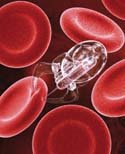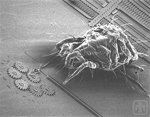The Economist (print edition)
Feb 14th 2008
At the moment nanofibres are made in a variety of ways, none of which is entirely satisfactory. One uses condensation and evaporation, and is rather like some of the steps employed to make the fine structures on silicon chips. Screen-printing techniques are also being developed for some materials. A third trick relies on a system known as electrospinning, which dates back to the 1930s. In this, an electrically charged syringe squirts a polymer mixed with a solvent towards an oppositely charged electrode. The voltage difference causes a jet of the solution to stream from syringe to electrode. On the way, the solvent evaporates and the fibre solidifies. The technique works well enough, but the fibre that piles up on the receiving electrode tends to break up on arrival. It can end up looking like a plate of spaghetti.
By comparison, the fibres made by Dr Yu are nice and straight—and also astonishingly long. Most nanofibres are only nanometres in length as well as width, but the longest one made by Dr Yu stretches for half a metre—and he only stopped there because he got fed up with winding it up on a spool only a few millimetres in diameter. In theory, his method should be able to produce nanofibres of any length.
That method relies, like electrospinning, on dissolving the stuff that is to become the fibre in a solvent. The tip of a micropipette 100 nanometres in diameter is used to draw up the beginning of the thread and pull it across a surface on which it can dry. As the solvent evaporates, what is left behind solidifies. After that, it is simply a question of reeling in the prey. As long as the thread does not break, it can be drawn. And by moving the pipette both horizontally and vertically it is possible to make three-dimensional patterns with more structure than a bowl of spaghetti. That means component-manufacture should be possible.
According to Dr Yu, his method will produce fibres at the rate of 3mm a second, which bodes well for turning it into an industrial process. It should thus provide an economical way of making nanofibres from a variety of materials, provided only that those materials are soluble in something that evaporates reasonably fast.
It should also allow some novel nanofibres to be produced for researchers to experiment with. One possibility Dr Yu foresees is to incorporate fibres into materials such as blocks of plastic, and then dissolve them away to create tiny channels through which fluids could flow. That would make so-called labs-on-a-chip, which are used for some sorts of chemical analysis, easier to fabricate. Another idea would be to make those embedded fibres from pairs of materials which, when laid together within a substance, may be made to react together to produce a composite with useful electrical or mechanical properties. And, if all else fails, at least it makes an entertaining alternative to fishing.







No comments:
Post a Comment